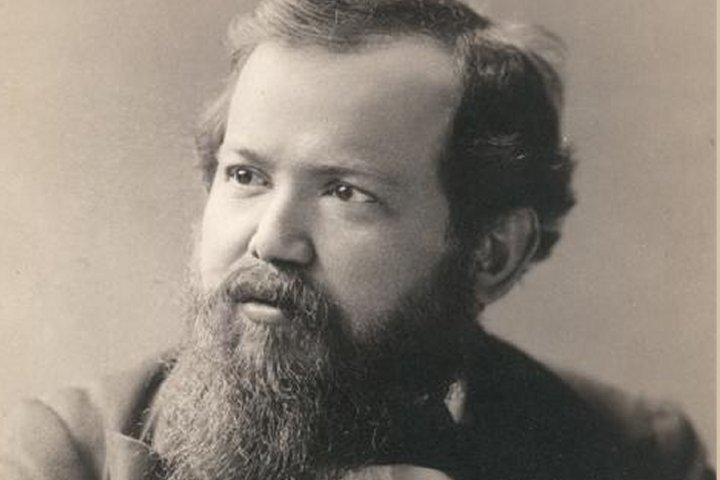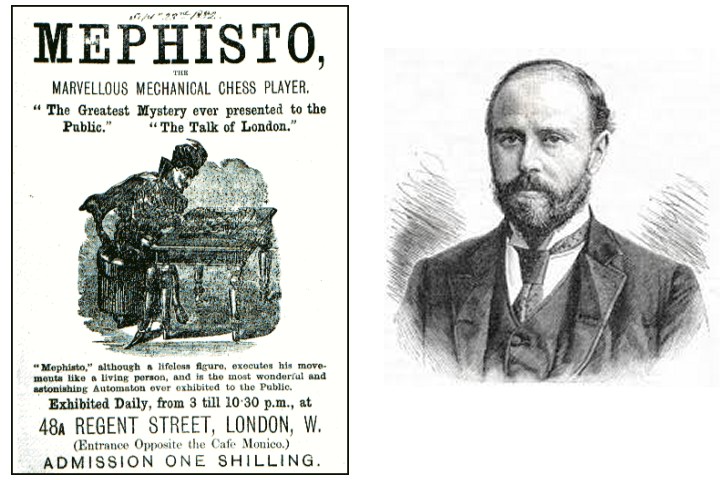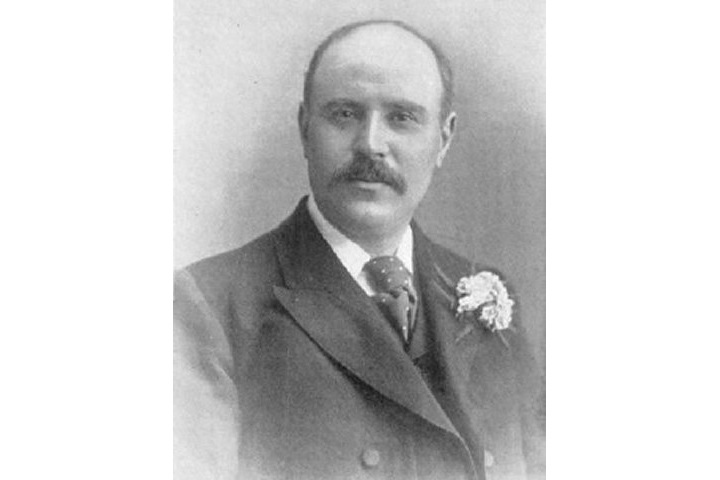Steinitz and Gunsberg had taken highly contrasting paths to the championship. Steinitz had long-established himself as a leading player. As far back as 1866, he was already regarded as the world’s best when he beat Adolf Anderssen in a 14-game match. Over the years he affirmed his supremacy. He won Vienna 1882. In 1886, he beat Johannes Zukertort in the first official world championship match, and then defended his title successfully in 1889 against Mikhail Chigorin.

Wilhelm Steinitz | Photo: Austrian National Library
Gunsberg, on the other hand, seemingly sprang out of nowhere in the 1880s and beat other strong contenders to the championship table. How good was he, and how did he develop into a top player? In the days when world champions chose their challengers, was he deserving of the chance Steinitz gave him? Gunsberg's life and career deserve to be recalled on the occasion of the 3rd World Championship Match's 132nd anniversary.
Gunsberg was born on November 2, 1854 in Pest, Hungary, the eldest son of Abraham Gunsberg and Katherine Tarpat. His father was born in 1805 in Kamenets Podolsky, a city in the Russian Tsarist Empire that was occupied by Poles, Ukrainians, Armenians, and Jews. The Gunsbergs were Jews.
Abraham Gunsberg was a traveling merchant who came to Hungary at some point. Isidor accompanied his father on his travels, and in 1863 they came to England while working for a Polish wine grower. The Gunsbergs did not settle there, but their frequent visits later led Isidor to take residence in London.
Abraham taught Isidor chess when he was about 11, and the boy’s talent immediately became apparent. When Abraham’s business brought him to Paris in 1867, he took Isidor to the Café de la Regence. Barely two years after learning the game, Isidor impressed the experienced players there, who called him "the second Morphy." It also happened that the great Paris International Tournament of 1867 was running, and father and son spectated. The round-by-round encounters among Ignatz Kolisch, Szymon Winawer, Steinitz, Gustav Neumann, and Samuel Rosenthal must have impressed the young Gunsberg.
In 1876, at the age of 21, Gunsberg returned to London in search of work opportunities. Back then, working men’s clubs promoting the social welfare of its members were rife in London, and Gunsberg became a member of a Jewish club. He was banking that his membership would secure him employment or promote a chess career, as the club had plenty of outstanding amateur members.
Team competitions ran among the various workingmen’s clubs, and Gunsberg made a name for himself as a strong player in these tournaments. Soon his games began appearing in chess columns of the Westminster Papers, the London Figaro, and The Field.
In 1878, Gunsberg’s chess career took a boost when he became the operator and brains of Charles Godfrey Gumpel's chess automaton, Mephisto. The automaton was not the first of its kind, but unlike its predecessors, the Turk and the Ajeeb, Mephisto did not conceal a human player. It relayed moves to its human operator confined in another room through electromagnetism.

Gunsberg operated Mephisto for a good part of the ten years it was on display. He won the Chess Counties Association’s annual tournament in 1878 as Mephisto, and encountered leading players such as Amos Burn and Chigorin. They may not have been aware that Gunsberg was manning the automaton.
Gunsberg’s stint as Mephisto and employment with Gumpel paved the way for a professional career. In one of his first professional matches, he lost to Joseph Blackburne, 7-6, despite enjoying the odds of a two-game lead.
Gunsberg reached his peak in the mid to late 1880s. In 1885, he won the British Chess Association (BCA) Championship in London. Soon after, he went to Germany and took part in Hamburg 1885. This was an international event organized by the German Chess Federation that pitted the strongest German masters against the best of Europe. Gunsberg finished clear first.
Hamburg 1885, Final standings
In 1886, Gunsberg beat Henry Bird in a match 6.5-2.5. The following year, he turned the tables on Blackburne, beating him in a race to five return-match, 5-2. That same year, 1887, he tied with Amos Burn for 1st in the BCA Championship in London, and won it outright the following year in Bradford.
Another year later, Gunsberg participated in one of the greatest tournaments of the 19th century, the 6th American Chess Congress in New York in 1889. It was a 20-player, double-round robin event that was supposed to produce Steinitz’s next challenger. With draws needing to be replayed, the mammoth tournament took fifty rounds and two months (March 25-May 27, 1889) to complete.
Gunsberg finished sole third behind Chigorin and Max Weiss, who both tied for first. The tie remained unbroken after a four-game playoff, but neither Chigorin nor Weiss was interested in playing for the world championship. Chigorin had lost his first world championship match only a month before the New York tournament began. He probably did not wish to mount a new challenge immediately. Weiss, on the other hand, was soon to leave chess for a banking career. Gunsberg thus earned the opportunity to challenge Steinitz, and the Manhattan Chess Club proposed to organize the match.

Mikhail Chigorin | Photo source: Wikipedia
Early in 1890, the Havana Chess Club arranged a race to 10 match between Gunsberg and Chigorin. Gunsberg felt that his game needed to "mature" before the world championship match with Steinitz. A more testing preparation could not have come his way.
The match with Chigorin turned out to be a seesaw affair where the players established two-game leads before they came to a stand-off at 9 wins apiece after 23 games. It was declared drawn.
Gunsberg had many doubters who believed players such as Blackburne or George Henry Mackenzie were stronger title contenders. The drawn match with Chigorin, however, proved that he was as strong as any other challenger, and had more than fair chances.
The world championship match with Steinitz was for the first to win 10 games, or for the most wins after 20 games. It began on December 9, 1890 in New York.
Steinitz and Gunsberg immediately showed their mettle. Steinitz won game 2, but Gunsberg took Games 4 and 5 to gain the lead. Steinitz then won two straight games of his own, Games 6 and 7, to retake the lead, and then padded it to two after winning Game 10. Gunsberg twice closed the gap to one game with victories in Games 12 and 16, but Steinitz immediately restored his two-game lead by winning Games 13 and 18. Steinitz then drew Game 19 to take the match, 6-4. It was the closest of the three world championship matches that had been played up to 1891.
Just as the chess world was expecting more out of Gunsberg after his fine world championship performance, his career stalled thereafter.
A few months after the match with Steinitz, Gunsberg’s wife, Jane, succumbed to tuberculosis. It was a tragic blow to Gunsberg, who was left with three very young sons to take care of and support. Playing abroad became extremely difficult. To make up for his loss of income from competing, he turned to writing.
Gunsberg wrote chess columns that ran for several years in the St. James Budget, the Pall Mall Gazette, and the Penny Illustrated Paper. He also wrote a book, Chess Openings, which was released in 1895, and which remained in print for about thirty years.
Gunsberg remarried in 1893. His second wife, Miriam Clarke, was a teacher and governess who assisted Gunsberg in running his columns. She wrote some of them herself and conducted interviews of Gunsberg's subjects. In an unbelievable stroke of misfortune, however, she passed away four years into the marriage from the same disease, tuberculosis. Left now with another child with Clarke, Gunsberg’s movement became more restricted than ever.
Gunsberg’s comeback to tournament play after the deaths of his first and second wife all followed a pattern. Rusty and out of practice, he would drop points to top, active masters, defeat less fancied ones, and fall in the middle or bottom half of the standings. In the great Hastings 1895, he finished 16th out of 22 strong participants. In Monte Carlo 1901 and 1902, he finished 7th and 10th out of 14 and 20 participants respectively. Virtually retired in his last major event, St. Petersburg 1914, he finished last.
Gunsberg’s prestige remained, nevertheless, and he became a popular lecturer in chess clubs at the turn of the new century. One amateur recalled him as "one of the finest lecturers of the day." He also took to organizing tournaments, and directed great ones such as Ostend 1905 and 1906, and Marienbad 1925. In 1908, he was granted British citizenship. He passed away on May 2, 1930.
Gunsberg, the last great Victorian master, was undoubtedly one of the world’s strongest players in the late 19th century. He affirmed this with his match victories over Bird and Blackburne, his triumph in Hamburg 1885, and his rise as a world title contender. His abrupt decline after the world championship match, however, has diminished and left his legacy less appreciated. His was a life and career that could have been more glorious, if only he was not plagued by tragic, personal losses.
Games
Gunsberg started as a Romantic, gambit-playing master, but he later evolved to be a very positional player. This reveals that he had understood and practiced the classical principles taught by his great rival, Steinitz. His wins against Blackburne, Mason, Chigorin, and Bird illustrate his slow, maneuvering, if somewhat unspectacular style. In Game 12 of his world championship match with Steinitz, however, he plays sharply. He was, no doubt, pressured to win after falling behind by two points.
Game 1 – Bird vs. Gunsberg, Hamburg, 1885.
Game 2 – Gunsberg vs. Blackburne, 13th match game, London, 1887.
Game 3 – Mason vs. Gunsberg, New York, 1889.
Game 4 – Gunsberg vs. Chigorin, 8th match game, Havana, 1890.
Game 5 – Gunsberg vs. Steinitz, 12th match game, New York, 1890.
Links
More articles by Eugene Manlapao...


























